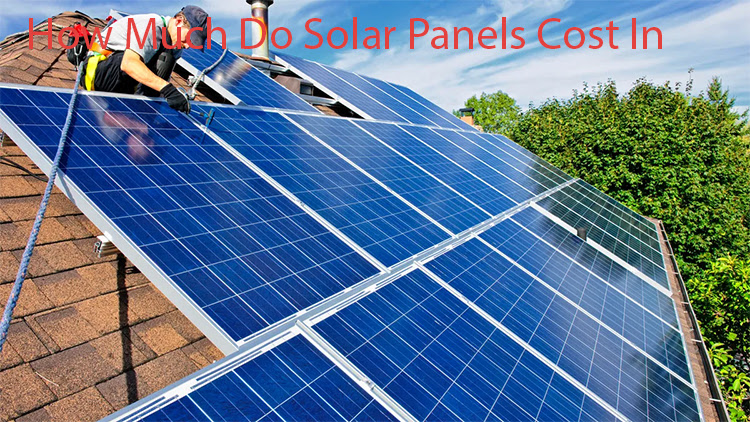The Solar Panels Cost can vary greatly, depending on factors such as location, the size of the system, and the type of solar panels used. On average, a 6kW solar system costs around $12,700. However, prices can range from $8,500 to $30,500. To budget for your solar panel investment, it’s important to understand where you might incur costs. For example, installation fees and additional equipment like batteries or inverters can add to the overall expense. Despite the initial cost, investing in solar panels can yield significant energy savings over time while also contributing to a greener future.
Before installing solar panels, it’s important to understand the costs involved. Factors like system size, panel type, and location can impact the overall cost. Residential solar panel systems typically range from $15,000 to $25,000. However, there are federal and state incentives available to help offset these expenses. To get an accurate cost estimate tailored to your needs, consult a reputable solar installation company. They can guide you through the process of accessing rebates and tax credits to reduce your expenses. While the upfront investment may seem significant, solar panels can lead to long-term energy bill savings and increase your home’s value while reducing your carbon footprint.
Outlines Of Guide
ToggleSolar Panels Cost by State
| STATE | AVERAGE COST FOR 6-KW SYSTEM WITH 30% FEDERAL TAX CREDIT APPLIED | AVERAGE COST FOR RESIDENTIAL ELECTRICITY(October2023) | AVERAGE HOUSEHOLD KWH USE PER MONTH | DERIVED ESTIMATED YEARLY SAVINGS ASSUMING 100% SOLAR COVERAGE OF ELECTRICAL NEEDS | DERIVED ESTIMATED NUMBER OF YEAR TO “BREAK EVEN” ON INVESTMENT |
|---|---|---|---|---|---|
| Alabama | $10,542 | 15.02 ¢/kWh | 1,178 | $2,123 | 4.97 |
| Alaska | $10,941 | 23.98 ¢/kWh | 580 | $1,669 | 6.56 |
| Arizona | $10,654 | 14.52 ¢/kWh | 1,061 | $1,849 | 5.76 |
| Arkansas | $11,771 | 12.71 ¢/kWh | 1,110 | $1,693 | 6.95 |
| California | $11,666 | 26.72 ¢/kWh | 535 | $1,715 | 6.8 |
| Colorado | $12,278 | 14.54 ¢/kWh | 692 | $1,207 | 10.17 |
| Connecticut | $12,558 | 28.95 ¢/kWh | 716 | $2,487 | 5.05 |
| Delaware | $11,414 | 17.46 ¢/kWh | 941 | $1,972 | 5.79 |
| District of Columbia | $12,100 | 18.02 ¢/kWh | 685 | $1,481 | 8.17 |
| Florida | $11,788 | 15.48 ¢/kWh | 1,111 | $2,064 | 5.71 |
| Georgia | $11,634 | 13.75 ¢/kWh | 1,096 | $1,808 | 6.43 |
| Hawaii | $11,466 | 42.69 ¢/kWh | 515 | $2,638 | 4.35 |
| Idaho | $12,107 | 12.15 ¢/kWh | 1,005 | $1,465 | 8.26 |
| Illinois | $13,146 | 15.83 ¢/kWh | 720 | $1,368 | 9.61 |
| Indiana | $13,230 | 15.17 ¢/kWh | 950 | $1,729 | 7.65 |
| Iowa | $12,348 | 13.37 ¢/kWh | 888 | $1,425 | 8.67 |
| Kansas | $11,172 | 13.72 ¢/kWh | 928 | $1,528 | 7.31 |
| Kentucky | $11,172 | 12.99 ¢/kWh | 1,094 | $1,705 | 6.55 |
| Louisiana | $11,907 | 11.92 ¢/kWh | 1,231 | $1,761 | 6.76 |
| Maine | $13,461 | 29.13 ¢/kWh | 583 | $2,038 | 6.61 |
| Maryland | $12,401 | 18.40 ¢/kWh | 968 | $2,137 | 5.80 |
| Massachusetts | $15,162 | 28.02 ¢/kWh | 577 | $1,940 | 7.82 |
| Michigan | $13,377 | 19.06 ¢/kWh | 652 | $1,491 | 8.97 |
| Minnesota | $13,083 | 15.29 ¢/kWh | 773 | $1,418 | 9.23 |
| Mississippi | $11,361 | 13.67 ¢/kWh | 1,186 | $1,946 | 5.84 |
| Missouri | $11,792 | 12.42 ¢/kWh | 1,077 | $1,605 | 7.35 |
| Montana | $11,067 | 12.96 ¢/kWh | 908 | $1,412 | 7.84 |
| Nebraska | $12,390 | 11.76 ¢/kWh | 1,043 | $1,472 | 8.42 |
| Nevada | $10,752 | 14.63 ¢/kWh | 939 | $1,649 | 6.52 |
| New Hampshire | $13,818 | 25.76 ¢/kWh | 623 | $1,926 | 7.17 |
| New Jersey | $12,222 | 22.70 ¢/kWh | 682 | $1,858 | 6.58 |
| New Mexico | $12,065 | 14.50 ¢/kWh | 659 | $1,147 | 10.52 |
| New York | $13,083 | 22.70 ¢/kWh | 592 | $1,613 | 8.11 |
| North Carolina | $11,487 | 14.75 ¢/kWh | 1,072 | $1,897 | 6.06 |
| North Dakota | $10,332 | 11.66 ¢/kWh | 1,119 | $1,566 | 6.60 |
| Ohio | $11,498 | 16.01 ¢/kWh | 874 | $1,679 | 6.85 |
| Oklahoma | $11,102 | 13.27 ¢/kWh | 1,155 | $1,839 | 6.04 |
| Oregon | $12,285 | 13.24 ¢/kWh | 946 | $1,503 | 8.17 |
| Pennsylvania | $12,233 | 18.43 ¢/kWh | 854 | $1,889 | 6.48 |
| Rhode Island | $13,419 | 31.78 ¢/kWh | 589 | $2,246 | 5.98 |
| South Carolina | $11,519 | 14.47 ¢/kWh | 1,088 | $1,889 | 6.1 |
| South Dakota | $10,192 | 12.99 ¢/kWh | 1,058 | $1,649 | 6.18 |
| Tennessee | $12,054 | 12.57 ¢/kWh | 1,188 | $1,792 | 6.73 |
| Texas | $11,088 | 14.71 ¢/kWh | 1,178 | $2,079 | 5.33 |
| Utah | $11,288 | 11.22 ¢/kWh | 783 | $1,054 | 10.71 |
| Vermont | $12,915 | 22.11 ¢/kWh | 568 | $1,507 | 8.57 |
| Virginia | $12,170 | 14.27 ¢/kWh | 1,086 | $1,860 | 6.54 |
| Washington | $12,485 | 11.34 ¢/kWh | 1,013 | $1,379 | 9.05 |
| West Virginia | $11,813 | 15.07 ¢/kWh | 1,074 | $1,942 | 6.08 |
| Wisconsin | $12,842 | 17.05 ¢/kWh | 684 | $1,400 | 9.17 |
| Wyoming | $11,046 | 12.47 ¢/kWh | 891 | $1,333 | 8.29 |
Solar Panels Cost by Type
When budgeting for a solar panel system, you will likely encounter three different types of solar panels, each with its own price point. The first type is monocrystalline solar panels. These are generally the most expensive option but also offer the highest efficiency levels. The second type is polycrystalline solar panels, which are slightly less efficient but also more affordable than monocrystalline panels. Finally, there are thin-film solar panels, which are the least expensive and least efficient option. When choosing which type of solar panel to install, it’s important to consider both the upfront cost and long-term energy savings to make an informed decision that fits your budget and needs.
Monocrystalline Solar Panels
Monocrystalline solar panels are the most popular choice for solar panel installations, costing an average of $1 to $1.50 per watt. These panels are made using a single silicon crystal, grown in labs and cut into thin octagonal discs that are attached to the panel for maximum efficiency. While this higher efficiency makes them a preferred choice for homeowners and businesses alike, their cost is also significantly higher than other types of solar panels. This means that they may not be the best option for those on a tight budget or looking for a more affordable solution. However, if you’re willing to pay more upfront, monocrystalline solar panels can offer significant long-term savings on energy bills and may be worth the investment.
Polycrystalline Solar Panels
When it comes to pricing, polycrystalline solar panels cost around $.90 to $1.50 per watt on average. Both monocrystalline and polycrystalline solar panels are photovoltaic (PV) panels that convert sunlight into electricity. However, the composition of these two types of panels is different. While monocrystalline cells are made up of a single crystal of silicon, polycrystalline cells consist of fragments of silicon crystals that are molded into wafer-like shapes. This manufacturing shortcut leads to lower production costs but also results in less efficient products compared to their monocrystalline counterparts.
Thin-Film Solar Panels
Thin-film solar panels are a cost-effective solution for those seeking to install solar panels. With a price range of $0.50 to $1.50 per watt, they are the most affordable type of solar panel available in the market. They use photovoltaic materials, but unlike other types of solar panels, thin-film cells use amorphous silicon instead of crystalline silicon, which makes them more efficient at absorbing light. Thin-film solar panels are also environmentally friendly as they are cheaper to produce and use readily available materials, making them an ideal option for those looking to reduce their carbon footprint.
Thin-film solar panels are a great option for RVs due to their lightweight properties and portability. However, they do have some drawbacks compared to traditional photovoltaic (PV) panels. Thin-film panels typically have lower efficiency, which means that more space is required to generate the same amount of energy as PV panels. Additionally, thin-film panels have a shorter lifespan, lasting between 10 to 20 years compared to PV panels that can last up to 25 years or more. Despite these limitations, thin-film solar panels remain an excellent choice for those who prioritize mobility and ease of use while still being able to generate renewable energy on the go.
Average Cost by Panel Type
| Panel Type | Cost Per Watt | 6kW System Cost (materials only) |
|---|---|---|
| Monocrystalline | $1.00 – $1.50 | $6,000 – $9,000 |
| Polycrystalline | $0.90 – $1.50 | $5,400 – $6,000 |
| Thin-film | $0.50 – $1.50 | $3,000 – $9,000 |
Average Cost by Solar System Size
The cost of installing a 6kW solar panel system can vary based on the state you reside in. On average, it can range from $10,200 to $15,200 after accounting for the 30% solar tax credit. Nevertheless, it’s important to note that every home has unique energy demands, and the prices of solar panels can fluctuate depending on the size of your system. It is therefore essential to evaluate the costs of different sizes of solar systems before settling on one. For instance, a 3kW system might be best suited for a smaller home or condo unit while larger homes with higher energy demands may require a bigger system like an 8kW or 10kW system. Additionally, beyond just the cost of installation, homeowners should also consider long-term benefits such as lower utility bills and increased property value when weighing their options.
| Solar System Size | Average Annual System Output* (kWh) | Average Cost Before Federal Tax Credit | Average Cost After Federal Tax Credit (30%) |
|---|---|---|---|
| 5kW | 4,000 – 5,000 kWh | $12,150 – $18,100 | $8,500 – $12,700 |
| 6kW | 8,000 – 10,000 kWh | $14,600 – $21,700 | $10,200 – $15,200 |
| 8kW | 10,500 – 13,300 kWh | $19,400 – $29,000 | $13,600 – $20,300 |
| 10kW | 13,300 – 16,700 kWh | $24,300 – $36,200 | $17,000 – $25,300 |
| 12kW | 16,000 – 20,000 kWh | $29,200 – $43,500 | $20,400 – $30,500 |
Solar Panel Installation Costs
The cost of installing solar panels in your home varies based on factors such as wattage, sunlight, and local incentives. Larger systems are more expensive than smaller ones. More sunlight leads to higher energy production and lower costs over time. Local incentives like tax credits can offset the initial cost. Other factors include panel type, labor costs, and additional equipment for optimal performance. Considering all these factors is crucial for a cost-benefit analysis. Going solar reduces reliance on traditional sources and lowers utility bills in the long run.
Price Per Watt
The cost of solar panels, including installation, ranges from $2.40 to $3.60 per watt. The total cost of your system will depend on how many watts are required to power your home. To calculate this, you need to take into account your energy consumption and the number of hours of sunlight in your area. A larger system will generate more electricity and cost more upfront, but it may also save you more money on your energy bills in the long run. Additionally, there are various financing options available that can make solar panel installation more affordable for homeowners.
Amount of Sunlight
The cost of installing solar panels can fluctuate depending on the amount of sunlight your panels receive. This, in turn, is influenced by a variety of factors such as location, climate, topography, and shade coverage. Areas with more sunlight will generally have a higher output and require fewer panels to generate power. In contrast, areas with less sunlight will need more panels and may require additional equipment to boost efficiency. It is essential to consult with a professional installer who can assess these variables and provide an accurate estimate for your solar panel installation costs.
Local Incentives
If you’re considering installing a solar panel system, it’s important to research local and state incentives that may be available to offset the cost. Many local governments offer incentive programs that can significantly reduce the price of solar panels. For instance, some programs can bring down the cost by as much as $2,500 or more. Another option to consider is referral programs offered by local solar panel installation companies, which often provide discounts or other incentives for referring new customers. By taking advantage of these programs, you can make your solar panel installation more affordable and reap the benefits of clean energy for years to come.
To find the best incentives near your location, you can utilize the Database of State Incentives for Renewables and Efficiency (DSIRE). This comprehensive online resource provides information about each state’s policies and incentives, helping you to identify the most suitable ones that cater to your needs. The DSIRE database offers a wide range of incentives, including tax credits, rebates, grants, and other financial assistance programs. By taking advantage of these incentives, you can reduce your energy costs and contribute towards creating a more sustainable future.
Factors That Determine Solar Installation Costs
When it comes to the cost of solar panels, several factors come into play. The price can depend on the solar company you choose, the number of panels needed to meet your energy requirements, and the type of panels that are suitable for your location. Other factors such as federal tax credits, installation fees, and maintenance costs may also affect the overall cost. Understanding these factors can help you make an informed decision when choosing a solar panel system that fits your budget and energy needs. It is recommended that you compare different solar companies’ prices and offerings before making a final decision. Additionally, investing in high-quality panels may initially seem more expensive but could save you money in the long run with increased efficiency and durability.
Solar Companies
When considering the cost of solar panels, several factors come into play. The company you choose, the solar equipment system, installation costs, and add-ons all contribute to the overall expense. It’s important to shop around and compare different companies based on reputation, experience, and customer service. Don’t solely focus on cost; quality and support matter too. Research online reviews, seek recommendations from others who have installed solar panels, and request quotes from shortlisted companies before making a decision.
Size, Weight & Number of Panels
To power your home entirely with solar energy, you will typically need between 20 to 25 solar panels. However, the actual number of panels required can vary from 15 to 34 depending on factors such as your home’s size, panel efficiency, and sunlight availability. The cost of solar panels ranges from $2.40 to $3.60 per watt, and the more energy your system needs to generate, the higher the cost will be. It is essential to consider these factors when determining the optimal number of solar panels needed to power your home efficiently while keeping costs manageable. Additionally, it is recommended that you consult with a professional solar installer who can assess your specific needs and provide personalized recommendations for your home’s solar panel requirements.
Federal Solar Tax Credit
The federal solar tax credit is a valuable incentive for homeowners who wish to install solar panels in their homes. It is essentially a rebate that can be applied to your tax return as a tax reduction. If you purchase solar panels between 2022 and 2032, you are eligible for a 30% tax credit. However, the credit will decrease to 26% in 2033, 22% in 2034 and ultimately expire in 2035. For an average $18,150 solar panel system, you can save approximately $5,400 on the cost of your solar panels. With the tax credit applied, your final price comes down to around $12,700 which makes it a more affordable option for homeowners who want to switch to renewable energy sources.
Type of Panels
When installing a solar system, the type of solar panel you choose plays a role in determining the material costs. The prices of solar panels can range from $0.90 to $1.50 per watt, with monocrystalline solar panels being on the higher end, polycrystalline panels falling in the middle range and thin-film solar panels being a cost-effective option. It is worth noting that monocrystalline solar panels offer better efficiency compared to other types of solar panels and can yield better returns on investment when it comes to energy savings. Therefore, it’s essential to consider the efficiency factor when choosing a type of solar panel for your system as it will have an impact on long-term savings.
Solar Panel Manufacturer
When it comes to solar panels, efficiency can vary greatly between manufacturers. SunPower is known for producing top-quality panels that have an impressive efficiency rating of nearly 23%, which surpasses the efficiency of other panels that may only reach 19% or 20%. This means that SunPower’s panels are able to convert a higher percentage of sunlight into electricity, making them a great option for those looking to maximize their energy output. It is important to consider efficiency when choosing solar panels, as higher-efficiency panels may cost more upfront but can ultimately save you money in the long run by generating more power and reducing your overall energy costs.
Investing in high-efficiency solar panels can be a wise decision for homeowners looking to save money in the long run. These panels require fewer units to generate the same amount of energy, which means less installation space and lower costs overall. Though the initial cost of these panels may be higher, around $3.60 per watt, their efficiency can result in significant savings over time. Additionally, high-efficiency solar panels are designed to perform better in low light conditions and can help maximize your energy output even during cloudy weather or shorter daylight hours.
Efficiency
When selecting a solar panel system for your home, choosing high-efficiency solar panels can result in more energy savings. These panels reflect more sunlight and efficiently convert it into electricity. However, they are usually more expensive than their less efficient counterparts. Hence, it is important to weigh the pros and cons of investing in high-efficiency solar panels before making a decision based on your budget and energy needs. Some homeowners may opt for polycrystalline solar panels instead of monocrystalline ones due to the lower cost of the former and their ability to offset the higher price tag of the latter. Nonetheless, investing in high-efficiency solar panels can result in long-term savings on energy bills, making it a wise decision for some homeowners.
Location
The number of solar panels required for a home can vary depending on the location and environmental factors. A house situated on top of a hill in Arizona with minimal tree coverage will require fewer solar panels than a home in wet and rainy Western Washington that is surrounded by trees. It is crucial to consider your surroundings and location to calculate the number of solar panels necessary for your property. This way, you can ensure that you have enough solar panels to generate sufficient energy for your household, while also being mindful of the expenses incurred in the process.
Roof Pitch
The pitch of a roof can have a significant impact on the cost of installing solar panels. Roofs with steeper pitches are more challenging to work on, and therefore, require more time and expertise to install solar panels. Solar panel companies may reflect this complexity in their quotes, resulting in higher installation costs for homeowners with steeply pitched roofs. Additionally, the orientation and shading of the roof can also affect the efficiency of the solar panels, so it is crucial to consult with a professional before deciding on an installation plan.
Type of Mount
The choice of mounting system for your solar panels can have a cost impact ranging from $15 to $750 per panel. Here are the different types of mounts:
- Fixed mount: This category of mount is the typical rooftop mount, with prices ranging from $15 to $50 per unit.
- Ground mount: A ground mount system is installed on the ground rather than on your roof, with a cost ranging from $70 to $200 per panel.
- Adjustable mount: Adjustable mounts for solar panels can be adjusted up or down to optimize sunlight reception. The price of these mounts ranges from $30 to $250 per panel.
- Dual-axis tracker: The tracking mounts move with the sun during the day, increasing the amount of sunlight captured by your solar panels by 25% to 45% compared to a regular mounting system. The cost of these mounts ranges from $450 to $775 per solar panel.
Additional Solar Panel Costs to Consider
When you install solar panels, there are extra expenses to consider apart from the initial installation. This includes maintenance and cleaning costs, home insurance, monitoring expenses, tree trimming charges, roof repair fees, solar panel repairs, and solar roof expenses. Proper maintenance and cleaning are vital for the optimal performance and longevity of the solar panels. It may be necessary to update home insurance to cover the added value of the solar equipment. Regular monitoring can help detect any issues early and prevent expensive repairs in the future. Tree trimming is essential to prevent branches from shading the panels. Having a plan in place for repairs or replacements is crucial in case of any damage or malfunctioning of the panels or roof. Although the upfront cost of installing solar panels may appear high, taking these additional expenses into account can help you decide whether solar energy is a viable option for your home.
Maintenance
To ensure that your solar panels continue to perform at their optimum level, it is crucial to conduct regular maintenance. The cost of maintaining solar panels can range from $140 to $180 per year, with an average of $150 if you hire a professional for the task. During the maintenance process, the pro will inspect the panels for any signs of repairs that may be required. It is worth noting that proper maintenance can help extend the lifespan of your solar panel system and maximize its energy production efficiency.
Cleaning
Hiring a solar panel company to clean your solar panels will cost an additional $150 per cleaning. However, for someone with the necessary equipment, safety knowledge, and experience, this could be a DIY-friendly task that only requires a one-time payment of approximately $100.
After you purchase the necessary cleaning equipment, such as an extension ladder, garden hose spray attachments, squeegees, soft brushes, and a one-gallon handheld sprayer, you can essentially clean your panels without additional cost, aside from the labor and time involved. However, it is not advisable to take on this project without the required skills. Prioritizing safety is crucial, even if it means spending more. Regular cleanings on an annual basis can enhance the efficiency of your panels by preventing debris and dust from obstructing sunlight access to the panels.
Home Insurance
Solar panels are a valuable investment for homeowners, as they can increase the value of their property by up to 4.1%, according to a study conducted by Zillow. However, it’s important to note that installing solar panels may also affect your homeowners insurance rates. Before making any decisions, it’s crucial to check with your insurance provider to understand how solar panels can impact your premiums. While some insurers may offer discounts for installing solar panels, others may consider them an added liability and raise your rates accordingly. Additionally, it’s important to ensure that your solar panel system is properly installed and maintained to avoid any potential hazards or damage that could impact your coverage.
Solar System Monitoring
When selecting a solar panel company, it’s worth checking if they offer complimentary solar system monitoring. This feature provides real-time data of your solar panel production and electric usage, allowing you to modify your lifestyle and maximize the output of your solar panel system. With this information, you can make informed decisions about energy usage and ensure that you are getting the most out of your investment in solar energy. Additionally, some solar installers offer advanced monitoring systems that provide detailed analytics and insights into energy consumption patterns, which can help identify areas for further energy efficiency improvements.
Elevation Solar is an excellent example of a solar company that prioritizes whole-home energy efficiency solutions. Unlike other companies, such as Palmetto Solar, that may charge additional fees for monitoring services, Elevation Solar offers comprehensive solutions without any hidden charges. It’s essential to read the fine print of your solar panel installation company before making a purchase to avoid any unexpected surprises or additional expenses. By choosing a reputable and transparent solar company like Elevation Solar, you can achieve significant savings on your energy bills while minimizing your carbon footprint.
Tree Trimming
If you’re planning on installing solar panels, it may be necessary to invest in tree trimming services to ensure that sunlight can reach the installation site. The cost of tree trimming typically ranges between $250 and $700 per tree, depending on factors such as the size and location of the tree. While this may add an additional cost to your solar panel installation, it is a worthwhile investment as it can significantly improve the efficiency and effectiveness of your system. Additionally, regular tree maintenance can prevent potential damage from falling branches or trees during severe weather conditions.
Roof Repair
Before installing solar panels on your roof, it’s important to ensure that the roof has a solid foundation. This may involve repairing or replacing old roofing to protect your home from the elements and to eliminate any potential hazards associated with the installation of solar panels. The cost of repairing a roof typically ranges from $150 to $7,000, while replacing a roof can cost between $6,700 to $80,000, with an average cost of $11,500. Investing in a new roof before installing solar panels can ultimately save money in the long term by preventing issues related to a weak foundation. Moreover, a newer roof can enhance the value of your home, making it more appealing to potential buyers if you choose to sell in the future.
Solar Panel Repair
If you’re looking to repair solar panels, the cost can vary widely depending on the extent of the damage. In general, repairing a small crack is the most affordable option, ranging from $200 to $500. However, if there is significant damage or if the inverter needs repair, you can expect to pay up to $1,700 for the job. It’s important to note that regular maintenance and inspections can help prevent costly repairs down the line, so it’s worth investing in professional maintenance services for your solar panel system. Additionally, many solar panel manufacturers offer warranties and service plans that can help cover repair costs in case of unexpected damage or malfunction.
If you’re experiencing issues with your solar panels, it’s worth checking if you have an active warranty through your installation company or manufacturer. Many solar panel manufacturers offer a 25-year warranty, which could potentially save you money on repair costs. Additionally, it’s important to understand the terms and conditions of your warranty to ensure that you’re eligible for coverage. Some warranties may only cover certain types of damage, so it’s best to review the policy thoroughly before making any repairs or replacements.
Solar Shingles and Tiles
Solar shingles are an innovative and eco-friendly alternative to traditional roofing solutions. While the average cost for solar shingles ranges from $15,000 to $20,000, Tesla roofs and Powerwalls come with a battery storage system that can significantly increase the cost. However, these systems offer long-term benefits as they help reduce energy bills and carbon footprint. Additionally, solar roofs not only protect your home from the elements but also add an attractive, energy-efficient bonus to your property. With advances in technology and decreasing production costs, solar shingles are becoming an increasingly popular option for homeowners looking to make their homes more sustainable.
When to Install Solar Panels
Many people believe that summer is the best time to install solar panels, but winter can actually be a better option in certain circumstances. The lower demand for solar services during winter may lead to lower installation costs as a whole. However, weather conditions must be taken into account before deciding on the best time to install solar panels. In regions with icy or snowy weather, it may not be ideal to install solar panels during winter due to potential safety hazards and decreased efficiency due to reduced sunlight exposure. It is important to consider your climate and consult with a professional before making a decision about installing solar panels on your home.
Installing solar panels in the winter is efficient because solar installation companies are less busy during the off-season, so your panels are likely to be installed more quickly. Additionally, the entire design, permit acquisition, and installation process can take several weeks or months to finish. Even if winter isn’t the ideal time for solar installation in your area, starting the process during the cold weather can ensure that your panels are operational by summer.
How Much Do Solar Panels Save?
While there is an initial cost associated with solar panels, they have the potential to provide long-term savings for homeowners. The amount of money that solar panels can save depends on various factors, such as the daily sunlight exposure, roof angle, and system size. Local electricity rates play a crucial role in determining the potential savings from solar panels.
To calculate the annual savings from your solar panels, first figure out your yearly electricity expenses. For instance, in 2022, the average American household spends approximately $1,623 per year on electricity, as reported by the Energy Information Administration (EIA). Next, factor in your current utility rate, considering that utility rates typically rise by 2.2% annually (another incentive to invest in solar panels).
Utilize an internet-based tool to calculate your yearly savings by entering details such as your location, energy consumption, and the present average cost of solar panel setup in your region. Many people mistakenly believe that solar panels will completely eliminate your electric bills. Although this is not always true, solar panels do substantially decrease your monthly electricity costs and are a valuable investment.
How Can I Pay for Solar Panels?
Solar panels are a significant investment for homeowners, but they can reap the benefits of lower utility costs once the panels are installed. The cost of solar panels can vary from $8,500 to $30,500 when paid outright. However, there are several ways to pay for solar panels. One option is to take out a loan specifically designed for solar panel installation. Another option is to lease the system from a solar panel provider. This allows homeowners to pay a monthly fee instead of paying upfront costs. Additionally, some states offer incentives and tax credits for installing solar panels, which can help offset the initial investment cost. Regardless of how homeowners choose to pay for solar panels, the long-term savings on utility bills can make it a worthwhile investment in the long run.
Cash
If you have extra cash in the bank, paying for solar panel installation outright can be a smart decision. By owning your solar panels outright, you can take advantage of the generous rebate and tax incentives immediately. This can help offset the initial cost of installation and provide long-term savings on your energy bills. Additionally, owning your solar panels can increase the value of your home and potentially make it more attractive to potential buyers if you plan on selling in the future. However, it is important to weigh the upfront cost against potential long-term savings before making a decision on how to finance your solar panel installation.
Solar Loans
Solar loans make installing solar panels for your home more affordable and accessible. You can spread out the cost over time, reducing your financial burden. With little to no upfront payment, you can start using the panels immediately to power your home. Through monthly payments over a set period, you pay off the panel’s cost. The interest added to your payments, ranging from 2.99% to 36%, depends on your credit score, lender, and loan duration. Despite the increased overall costs, consider the long-term benefits of reduced electricity bills and a smaller carbon footprint. Some lenders offer flexible payment plans or even interest-free loans for those with good credit scores or high down payments. Research all available options and consult with a professional to determine the best financing option for your needs.
Solar Leases or Power Purchase Agreements (PPA)
Certain states allow homeowners to either lease solar panels or finance them through a power purchase agreement (PPA). With these arrangements, a third party will own and install the solar panel system on your roof, and you will make monthly payments to them for your energy usage. While some PPAs offer a fixed rate, others have an increasing payment schedule.
Leasing solar panels is an excellent way to take advantage of renewable energy at an affordable monthly cost. However, it’s essential to remember that you won’t own the panels, which means you won’t be eligible for tax benefits or rebates. Nevertheless, leasing solar panels does come with some advantages. For instance, you don’t have to worry about the installation and maintenance costs, as these are usually included in the lease agreement. Additionally, leasing solar panels allows you to reduce your carbon footprint and save money on your electricity bills over time. It is important to weigh the pros and cons of leasing versus buying before making a decision that best suits your budget and energy goals.
Cash-Out Refinance
If you are planning to refinance your mortgage, a cash-out refinance may be worth considering. This type of refinancing allows you to access the equity in your home and receive cash that can be used for various purposes such as home improvements or debt consolidation. The process involves taking out a new mortgage that is more than the balance of your existing mortgage. The difference between the two amounts is given to you in cash, which you can then use for any purpose you choose. However, it’s important to consider the potential risks and benefits of a cash-out refinance before proceeding. While it can provide immediate financial relief, it also increases your overall debt and may result in higher monthly payments. It’s advisable to consult with a financial advisor or mortgage professional before making a decision.
Home Equity Line of Credit (HELOC)
Home equity line of credit (HELOC) is an alternative financing option that enables homeowners to leverage their property’s equity and use it as a low-interest credit card. This means that you can access cash for home projects or other expenses without having to resort to high-interest loans or credit cards. The interest rate on a HELOC is typically lower than most other forms of financing, making it an attractive option for those looking to save money on interest payments. However, it is important to note that using your home as collateral comes with risks, and careful consideration should be given before pursuing this financing option.
How Long Does It Take to Break Even on Solar Panel Costs?
The average annual energy bill for households in 2022 was around $1,600. Investing in a solar energy system can be a cost-effective solution in the long run, but it does require an upfront investment. On average, a solar system costs between $10,200 to $15,200 after applying the tax credit. It can take anywhere from 6.4 to 9.5 years to break even on this investment, depending on various factors such as electricity costs and financing options. However, with incentives like local and federal tax credits, the payback period may be shorter or longer. It is important to consider all these factors before making a decision about installing a solar energy system for your home. Additionally, it’s worth noting that solar panels can increase the value of your property and provide environmental benefits by reducing your carbon footprint.
Calculate the time it will take to recoup your investment by deducting any incentives or rebates from the total system cost. Compare your utility bills before and after installing the solar system to assess the payback period. Divide the initial cost by your savings to determine the breakeven timeframe.
What Does the Solar Panel Installation Process Look Like?
Installing a solar energy system in your home is a significant investment, and it is essential to have a clear understanding of the installation process. Speaking to a solar energy consultant is highly recommended since there are several factors to consider, and each home’s layout and energy requirements are unique. A consultant can provide valuable insights into how long the installation process typically takes for homes similar to yours. They can also guide you through the entire installation process, from selecting the right panels to ensuring that your system meets all local regulations and safety requirements. With their help, you can be confident that your solar system will function efficiently and provide you with clean energy for years to come.
Check for Compatibility
Before installing a solar energy system, it is essential to prepare your home for the process. Firstly, you must ensure that your roof is spacious enough to accommodate the panels. Secondly, your electrical panel must be updated and in good condition so that it can handle the increased power load. This way, there won’t be any need to replace it soon. Additionally, your roof should be structurally sound and free from damage or leaks to ensure maximum efficiency and longevity of the solar panels. It’s recommended to have a professional assessment conducted to determine if your home is ready for solar panel installation.
Select the Size
After confirming that your roof is suitable for solar panel installation, the next step is to plan out how you want your system to function. This involves deciding on the amount of energy you need to power your home, whether it’s just a few appliances or enough energy to sell back to the power company. Your energy requirements will determine the size of the solar panel system you need to install. It is essential to work with a professional solar installer who can guide you through the process and ensure that your system meets your needs while maximizing its energy efficiency. A well-designed solar panel system can significantly reduce your electricity bills and provide long-term savings while reducing your carbon footprint.
Get Permits
Obtaining proper permits from local authorities is crucial before carrying out any installation work. The approval process for permits can be time-consuming, which can delay the project schedule significantly. In addition to waiting for permit approval, scheduling inspections is also a time-consuming aspect of the project. Delays caused by permit approvals and inspections can result in increased project costs and missed deadlines. Therefore, it is recommended that you plan ahead and ensure all necessary permits are obtained well in advance of the installation start date to avoid unnecessary delays.
Apply for Incentives
Incentive programs can be a valuable way to maximize the benefits of investing in solar energy. These programs vary depending on your location and state, and even federal incentives can change over time. Therefore, it is essential to research tax credits, rebates, or grants from multiple sources to offset costs associated with your solar project. It is important to apply for these incentives before starting any physical work on your installation. By doing so, you can ensure that you take full advantage of available incentives and make the most of your solar investment. It is also worth noting that some states offer net metering programs which allow homeowners to sell excess energy generated by their solar panels back to the grid, further reducing energy costs.
Preparation
Ordering all the solar panel components together is critical to ensure material compatibility and timely installation. As solar panel requirements vary based on location and needs, it is essential to order unique components that suit your project’s specific requirements. By ordering everything at once, you can avoid any potential compatibility issues with materials. Additionally, having all the required materials ready by the installation date can help expedite the process and streamline the entire installation process. It also ensures that there are no delays or setbacks that may occur if materials arrive late or are incompatible with each other.
Installation
After all the necessary preparations are made, it is time for the installation of solar panels. An important step in this process is installing the racking system, which provides a secure foundation for the panels to be mounted on. Once the panels are in place, other components such as the heat sink, charge controller, battery bank, power inverter and energy meter can be installed as well. Before connecting the entire energy system to the energy panel, it is imperative to double-check all wiring to ensure that everything is in order. Finally, connecting the energy system to the energy panel marks the completion of the installation process.
Are Solar Panels Worth It?
Solar panels have the potential to create significant savings for those looking to lower their electricity expenses and reduce carbon emissions. The key consideration in deciding if solar panels are a viable option for you is the current cost of your electricity. The greater your electricity expenses, the greater the long-term savings from a solar panel system. This can differ significantly depending on where you are located.
If you reside in an area with high utility rates, you can expect significant savings by investing in solar panels. Installing solar panels is a wise investment if done correctly. It is essential to do thorough research before selecting the right solar panel system for your home or business. Factors like the orientation and tilt of your roof, shading, weather patterns, and energy usage should be considered while deciding on the best system. Moreover, it is crucial to work with a reputable installer who can guide you through the process of selecting, installing, and maintaining your solar panel system. Over time, the savings on your energy bills will make up for the initial investment and help reduce your carbon footprint as well.
Cost of DIY Solar Panel Installation
While it is technically possible to purchase a DIY solar panel installation kit for about $1 to $2 per watt and install the system yourself, it is not recommended unless you are a professional. The installation process can be complex and dangerous, requiring knowledge of electrical wiring and roofing techniques. Additionally, there are potential safety hazards associated with working on a rooftop, such as falling or being electrocuted by live wires. Therefore, it is highly advised that you hire a licensed and experienced solar panel installer to ensure proper installation and prevent any accidents. Going this route may cost more upfront, but it will save you from any future damage repair costs.
Installing solar panels requires specialized skills, technology, heavy machinery, working at heights, and the potential for electrical hazards. In many locations, obtaining a permit and undergoing inspection is necessary, and certain states mandate a solar contractor license for installation. Incorrect installation may nullify the warranty. It is advisable to engage a local solar panel installation firm to ensure a safe and efficient setup.
Frequently Asked Questions of Solar Panels Cost
How much energy can you save with solar panels?
The most significant benefit of installing solar panels is that you will save energy and, in turn, electricity costs. If your solar panels are large enough, you can produce enough electricity for your home. But, even if your solar panels switch between the electricity from your solar panels to using energy from the National Grid, you’ll undoubtedly use less electricity and pay lower bills.
Do solar panels increase the value of your home?
Solar panels can lower your monthly energy costs and may enhance a home’s value for potential buyers compared to similar homes without solar panels. Keep in mind that homes equipped with a solar energy system could potentially sell for 4.1% more than those without.
How long does solar panel installation take?
The installation of solar panels can range from one to five days, with the majority of installations typically taking around three days. The duration of the installation process depends on factors such as the size of the system, weather conditions, and the ease of access to your rooftop.
What is net metering?
Net metering, also known as net energy metering, is a system that enables the transfer of solar energy generated by your panels to the grid. Your utility or electric company reimburses you for this energy by reversing your electric meter, resulting in reduced energy bills. Net metering is feasible only with a grid-tied solar system.
How long do solar panels last?
The average lifespan of a solar panel is 25 to 30 years, with some varieties lasting 40 years or more, and thin-film panels having a lifespan of 10 to 20 years. Many manufacturers offer limited warranties for 25 years, but it’s important to verify the specifications of your specific panels. These warranties usually require professional installation to be valid.
How much does a 6kW solar system cost?
The cost of installing a 6kW solar system ranges from $14,600 to $21,700. If eligible, a 30% tax credit can bring the final cost down to an average range of $10,200 to $15,200. It’s advisable to research solar energy incentives in your local area to determine potential credits or rebates for which you may be eligible.
How much does a 10kW solar system cost?
The typical 10kW solar system can range in cost from $24,300 to $36,200. With the solar tax credit, the expected payment for a panel of this capacity would fall between $17,000 and $25,300.











































